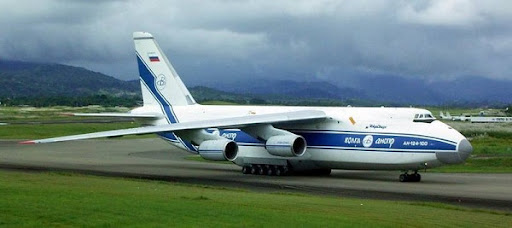I'm intrigued by the news that a relatively unknown US company has teamed up with Antonov of the Ukraine to offer the latter company's aircraft as a candidate for the US Air Force's KC-X competition to select a new aerial refueling tanker.
There's a lot of skepticism in aviation circles about the news. Pundits have pointed out that none of the proposed Antonov models have ever been used as aerial tankers (indeed, two of the three don't yet exist!); that the US partner, US Aerospace, has never built an aircraft in its life and appears to be in financial difficulties already; and that the project appears to depend on unnamed outside investors, who may or may not materialize. Also, Antonov in the Ukraine has been struggling to find financing for its projects since the breakup of the Soviet Union. There are rumors that Russia would like to see the company either fold up entirely, or move back to Russia so that the latter nation can control its output. I'm pretty sure the last thing Russia wants is for Antonov to partner with a Western firm, and it can be expected to mount vigorous opposition.
Nevertheless, the bare bones of the proposal as currently outlined have me thinking hard. There may be more to this than meets the eye. Even if the US Aerospace/Antonov partnership doesn't win the KC-X competition, they may have real prospects for sales of heavy-duty cargo aircraft in the longer term, particularly with their proposal to develop what they're calling the An-122; a twin-engine version of the four-engine An-124, the largest transport aircraft ever put into production in the Soviet Union (only a single prototype of its larger six-engine sibling, the An-225, was ever built).

Antonov An-124 transport aircraft
The An-124 is slightly smaller than the US Air Force's C-5 Galaxy transport aircraft, currently the largest in the USAF's fleet. Allegedly the An-124 can carry a slightly heavier load, although that depends on the 'authority' one consults. Basically, they're of equivalent performance.

C-5 Galaxy transport aircraft of the USAF
Both types can carry payloads in the 120-metric-tonne class, although a proposed upgraded version of the An-124 (not yet built) is claimed to be capable of lifting 150 metric tonnes. The USAF has used chartered An-124 aircraft for many years to airlift heavy freight between the USA and operational areas in Iraq and Afghanistan, supplementing the C-5 Galaxy fleet and sparing the latter from accumulating too much wear and tear.
The proposal to produce a twin-engine version of the An-124 (dubbed the An-122 in the US Aerospace/Antonov proposal) is a very interesting one. The An-124 is powered by four Ivchenko Progress D-18T turbofans, each producing 51,600 pounds of static thrust. They're noted for being fairly 'thirsty', not as economical as Western engines of the same generation, and there are reports that they require more maintenance than the latter as well. Be that as it may, the An-124's four engines produce a combined total of 206,400 pounds of thrust at maximum power.
Western engine technology has progressed by leaps and bounds since the An-124's engines were designed. The most powerful turbofan currently available is the General Electric GE90-115B, as fitted to the Boeing 777-300ER airliner.

Boeing 777-300ER airliner of All Nippon Airways
This engine produces a monstrous 115,000 pounds of static thrust at full throttle (and has been recorded at over 127,000 pounds of thrust, although the latter isn't a practical figure for routine operations). To give you an idea of just how much power that is, during testing on a Boeing 747 testbed aircraft (shown below), a single GE90 engine generated enough thrust to keep the Jumbo at flying speed with its other three engines idling.

Boeing 747-121 testing a General Electric GE90 engine intended for the Boeing 777
Two of those engines would produce a combined maximum thrust of 230,000 pounds - 11½% more than the four engines currently powering the An-124. There appears to be little reason why two of them could not be fitted to the latter aircraft, conferring a significant increase in power whilst simultaneously bringing greater fuel economy (likely to be at least a 10% improvement, possibly as high as 15%). That would, in turn, increase the range of the An-124 appreciably. The General Electric engines reportedly sell for around $24 million in 2009 dollars. Two of them would probably cost more than four of the older-model engines currently used on the An-124, but since they'd bring more power, improved reliability, reduced fuel consumption and better range, that's probably an expense worth paying.
Whether or not the US Aerospace/Antonov partnership is successful in winning the KC-X competition, they might just have a winner on their hands in a twin-engined version of the An-124. I'm sure the USAF would be interested, as would other air forces and commercial freight operators throughout the world, particularly if it can be put on the market at an economical price. Politics might derail sales to the USAF, of course, but there's nothing comparable in production anywhere in the world right now. That might trump a lot of potential opposition.
I'd like to see this one fly.
Peter
4 comments:
I never heard of this, but the idea intrigues me too.
Imagine that, an Antonov airframe in USAF paint. That'd be a hell of a thing.
I'd believe it if the transport aircraft idea is getting some mileage around those who decide, though.
Jim
I saw the An-225 a couple of times when it flew to Memphis on a couple of cargo runs. Got a few pictures of it on the ramp, and one or two as it flew directly over my house on final. An impressive sight it was.
I love your blogs. I just added this one to the USAE FB page here. http://www.facebook.com/U.S.Aeropsace
Stop by and say hi. Are you on twitter. I would love to connect there.
Post a Comment